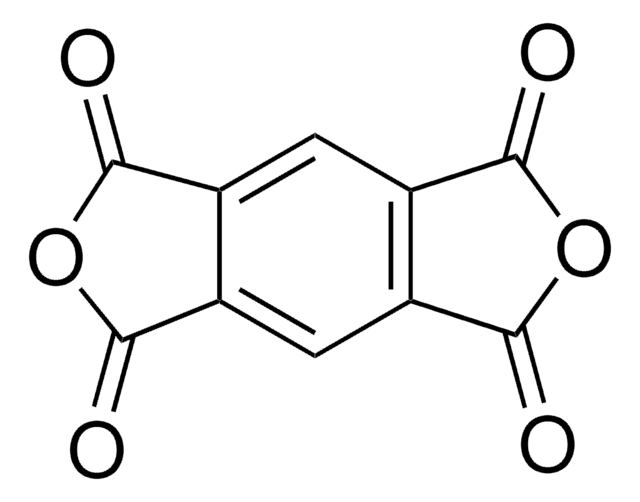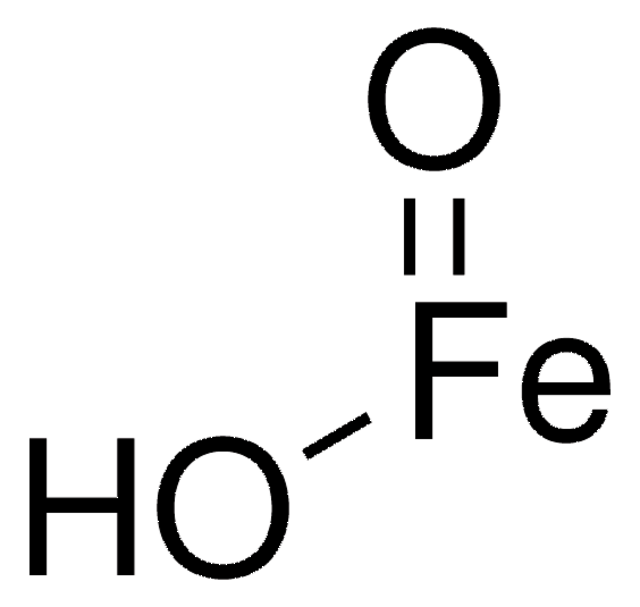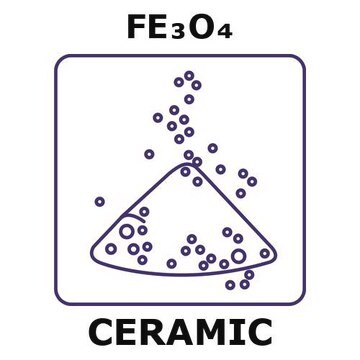推荐产品
品質等級
化驗
99.99% trace metals basis
形狀
powder
mp
1538 °C (lit.)
密度
4.8-5.1 g/mL at 25 °C (lit.)
應用
battery manufacturing
SMILES 字串
O=[Fe].O=[Fe]O[Fe]=O
InChI
1S/3Fe.4O
InChI 密鑰
SZVJSHCCFOBDDC-UHFFFAOYSA-N
正在寻找类似产品? 访问 产品对比指南
一般說明
Iron(II,III) oxide, also known as ferric ferrous oxide, with a purity of 99.99% trace metals basis, exhibits unique magnetic, electrical, and catalytic properties. It has density of 4.8-5.1 g/mL at 25 °C and melting point of 1538 °C , which indicates thermal stability and mechanical strength. In the field of biomedical applications, it has shown promise in magnetic resonance imaging (MRI) contrast agents and drug delivery systems due to its magnetic properties and biocompatibility. In the semiconductor industry, iron(II,III) oxide has been investigated for its potential use in spintronics and magnetic tunnel junctions, where its magnetic properties can be utilized for information storage and processing. Additionally, it is being explored for use as an anode material in lithium-ion batteries, offering high theoretical capacity and low cost due to its abundance.
應用
- Achieving Excellent Dielectric and Energy Storage Performance in Core-Double-Shell-Structured Polyetherimide Nanocomposites.: This study explores the development of polyetherimide nanocomposites incorporating Iron(II,III) oxide for enhanced dielectric properties and energy storage capabilities, showing potential for advanced electrical applications (Yuan et al., 2023).
儲存類別代碼
11 - Combustible Solids
水污染物質分類(WGK)
nwg
閃點(°F)
Not applicable
閃點(°C)
Not applicable
個人防護裝備
dust mask type N95 (US), Eyeshields, Gloves
其他客户在看
Jens Baumgartner et al.
Nature materials, 12(4), 310-314 (2013-02-05)
The formation of crystalline materials from solution is usually described by the nucleation and growth theory, where atoms or molecules are assumed to assemble directly from solution. For numerous systems, the formation of the thermodynamically stable crystalline phase is additionally
Marina I Siponen et al.
Nature, 502(7473), 681-684 (2013-10-08)
Magnetotactic bacteria align along the Earth's magnetic field using an organelle called the magnetosome, a biomineralized magnetite (Fe(II)Fe(III)2O4) or greigite (Fe(II)Fe(III)2S4) crystal embedded in a lipid vesicle. Although the need for both iron(II) and iron(III) is clear, little is known
Maoquan Chu et al.
Biomaterials, 34(16), 4078-4088 (2013-03-08)
The photothermal effect of Fe3O4 magnetic nanoparticles is investigated for cancer therapy both in vitro and in vivo experiments. Heat is found to be rapidly generated by red and near-infrared (NIR) range laser irradiation of Fe3O4 nanoparticles with spherical, hexagonal and wire-like
A Aranda et al.
Toxicology in vitro : an international journal published in association with BIBRA, 27(2), 954-963 (2013-01-30)
No consensus exists on how to address possible toxicity of nanomaterials as they interfere with most in vitro screening tests based on colorimetric and fluorimetric probes such as the dichloro-dihydro-fluorescein diacetate (DCFH-DA) assay for detection of oxidative species. In the
Tsung-Ju Li et al.
Biomaterials, 34(32), 7873-7883 (2013-07-24)
We present an approach for synchronizing hyperthermia and thermal-responsive local drug release. The targeting probe has a magnetite nanocrystal (Fe₃O₄@PSMA) core and a polynucleotide shell that carries 5-fluorouracil (5-FU) and anti-human epidermal growth factor receptor 2 (anti-HER2) antibody for cancer
商品
An article concerning self-propagating reactions induced by mechanical alloying, presented by Sigma-Aldrich.com.
Magnetism and magnetic materials have been of scientific interest for over 1,000 years. More recently, fundamental investigations have focused on exploring the various types of magnetic materials and understanding the magnetic effects created by electric currents.
我们的科学家团队拥有各种研究领域经验,包括生命科学、材料科学、化学合成、色谱、分析及许多其他领域.
联系技术服务部门






